DR-NC201iP(U) [US, LaES] 4-297-894-12 (1)
Noise Canceling
Headset
Operating Instructions
Manual de instrucciones
© 2012 Sony Corporation Printed in Malaysia
4-297-894-12(1)
DR-NC201iP
Utilizing the AI
Noise Canceling
The AI Noise Canceling function analyzes
environmental ambient sound components
and automatically selects the most effective
noise canceling mode.
When you press the AI NC button while the
POWER switch is set to “ON,” beep sounds
and the headset starts the analysis. During
the analysis (approx. 3 seconds), the POWER
indicator blinks, and no sound is heard from
the headset.
When the analysis is completed, the sound
reproduction starts with the most effective
noise canceling mode.
Noise canceling mode types
NC Mode A: Noise mainly in an airplane is
effectively reduced.
NC Mode B: Noise mainly in a bus or a train is
effectively reduced.
NC Mode C: Noise mainly found in an office
environment (PC, copier, air
ventilation, etc.) is effectively
reduced.
Tips
When the power of the headset is turned on,
NC Mode A is set.
Press the AI NC button again to reset the
noise canceling mode if ambient noise has
changed, such as when you move outdoors
from a room.
Hearing
environment sound
Press the MONITOR button while the POWER
switch is set to “ON.”
To cancel this function, press the MONITOR
button again.
Beep sound and
indicator status
Status/
Function
Beep sound Indicator
Power off No beep Lights off
Power on Beep once Lights on
AI NC Beep twice Blinks twice
MONITOR Beep once Blinks slowly
Low battery Long beep (2
seconds)
Blinks quickly
(30 seconds)
Precautions
What is noise canceling?
The noise canceling circuit actually senses
outside noise with built-in microphones and
sends an equal-but-opposite canceling signal
to the headset.
Notes on the noise canceling
function
Adjust the earpads so that they cover your
ears, otherwise noise canceling will not
function properly.
The noise canceling effect may vary
depending on how you wear the headset.
Do not cover the microphone of the headset
with your hands. The noise canceling
function may not work properly.
Microphone
After you turn on the power of the headset,
you may hear a slight hiss. This is the
operating sound of the noise canceling
function, not a malfunction.
–
–
–
–
–
–
English Noise Canceling Headset
WARNING
To reduce the risk of fire or
electric shock, do not expose this
apparatus to rain or moisture.
To reduce the risk of electrical
shock, do not open the cabinet.
Refer servicing to qualified
personnel only.
The validity of the CE marking is restricted
to only those countries where it is legally
enforced, mainly in the countries EEA
(European Economic Area).
This device complies with Part 15 of the FCC
Rules. Operation is subject to the following
two conditions: (1) this device may not cause
harmful interference, and (2) this device must
accept any interference received, including
interference that may cause undesired
operation.
The following FCC statement applies only
to the version of this model manufactured
for sale in the USA. Other versions may not
comply with FCC technical regulations.
NOTE
This equipment has been tested and found
to comply with the limits for a Class B digital
device, pursuant to Part 15 of the FCC
Rules. These limits are designed to provide
reasonable protection against harmful
interference in a residential installation.
This equipment generates, uses and can
radiate radio frequency energy and, if not
installed and used in accordance with the
instructions, may cause harmful interference
to radio communications. However, there is
no guarantee that interference will not occur
in a particular installation. If this equipment
does cause harmful interference to radio or
television reception, which can be determined
by turning the equipment off and on, the user
is encouraged to try to correct the interference
by one or more of the following measures:
Reorient or relocate the receiving antenna.
Increase the separation between the
equipment and receiver.
Connect the equipment into an outlet on
a circuit different from that to which the
receiver is connected.
Consult the dealer or an experienced radio/
TV technician for help.
You are cautioned that any changes or
modifications not expressly approved in this
manual could void your authority to operate
this equipment.
Using the Center
button
Operation Explanation
Single press Plays/pauses a track of
the connected iPod.
Double press Skips to the next track.
Triple press Skips to the previous
track.
Long press Starts the “VoiceOver*”
feature (if available).
Press once when
call is incoming
Answers the call.
Press again Ends the call.
Hold down for
about two seconds
Rejects an incoming call
(two low beeps confirm
the call was rejected).
* Availability of the “VoiceOver” feature
depends on iPod and its software version.
Note
Be careful not to unintentionally press any
buttons when you carry your iPod with this
headset connected.
–
–
–
–
2
3
4
How to use
Installing a battery
Connecting
Turning on the power
Utilizing the AI NC function
5
Wearing and controlling
Hearing environment sound After use
Turn off the power of the headset
The noise canceling function works for
noise in the low frequency band primarily.
Although noise is reduced, it is not canceled
completely.
The noise canceling effect may not be
pronounced in a very quiet environment, or
some noise may be heard.
When you use the headset in a train or a
car, noise may occur depending on street
conditions.
Mobile phones may cause interference and
noise. Should this occur, locate the headset
further away from the mobile phone.
Notes on using on the airplane
Do not use the headset when use of electronic
equipment is prohibited or when use of
personal headset for in-flight music services is
prohibited.
Notes on usage
Because the headset is of a high density
enclosure, forcing them against your ears
may result in eardrum damage. Avoid using
the headset where it is liable to be struck by
people or other objects, such as a ball, etc.
Pressing the headset against your ears may
produce a diaphragm click sound. This is not
a malfunction.
Clean the headset with a soft dry cloth.
Do not leave the plug dirty otherwise the
sound may be distorted.
Be sure to consult a Sony dealer when the
earpads become dirty or damaged, or when
the headset requires repair work.
Do not leave the headset in a location
subject to direct sunlight, heat or moisture.
Do not subject the headset to excessive
shock.
Handle the driver units carefully.
If you feel drowsy or sick while using this
headset, stop use immediately.
Notes on headset
High volume may affect your
hearing. For traffic safety, do not
use while driving or cycling.
As a headset reduces outside sounds, it may
cause a traffic accident. Also, avoid listening
with your headset in situations where hearing
must not be impaired, for example, a railroad
crossing, a construction site, etc.
Note on static electricity
Static electricity may cause mild tingling in
your ears.
To minimize the effect, wear clothes made
from natural materials.
If you have any questions or problems
concerning the system that are not covered
in this manual, please consult the nearest
Sony dealer.
Troubleshooting
No sound
Replace the battery with a new one.
You can listen to the music using the headset
even when the POWER switch is set to “OFF.”
In this case, the digital circuits for noise
canceling and high-quality sound are not
active, and the headset operates as a regular
headset.
Check the connection of the headset and the
equipment.
Check that the connected equipment is
turned on.
Turn up the volume of the connected
equipment.
Check if the MONITOR function is on (the
indicator blinks slowly). Press the MONITOR
button to turn it off.
The noise canceling effect is not
sufficient
The noise canceling function is effective
in low frequency ranges such as airplanes,
trains, or offices (near air-conditioning, etc.)
and is not as effective for higher frequencies,
such as human voices.
Turn on the headset.
Distorted sound
Turn down the volume of the connected
equipment.
–
–
–
–
–
–
–
–
–
–
–
–
–
–
–
–
–
–
–
–
–
Power does not turn on
Check if the battery has expired (the POWER
indicator lights off) and the battery is
inserted in the correcrt orientation. Replace
the battery with a new one or reinsert the
battery in the correcrt orientation.
No operation works
Set the POWER switch of the headset to “OFF,”
confirm the connections, and then set the
POWER switch back to “ON.”
The connected iPod does not work
Check if the cord is connected correctly.
Connect the L type plug to the iPod and the
other plug to the headset.
Features
Digital noise canceling headset with
Sony’s unique DNC Software Engine.
Creation of a high-precision canceling
signal delivers outstanding noise canceling
performance.
AI (Artificial Intelligence) Noise Canceling
function.
Select AI NC button for optimal noise
canceling mode based on intelligent analysis
of the environmental ambient noise.
Detachable cord with the handy and easy-to-
use remote control designed exclusively for
the iPod, iPhone and iPad.
In-line microphone for hands-free phone
calls of iPhone.
Specifications
General
Type Dynamic, closed
Driver units 40 mm, dome type (CCAW
adopted)
Power handling capacity
50 mW
Impedance 68 Ω at 1 kHz (when the
power is on)
35 Ω at 1 kHz (when the
power is off )
Sensitivity 103 dB/mW (when the power
is on)
102 dB/mW (when the power
is off )
Frequency response
8 Hz – 23,000 Hz
Total Noise Suppression Ratio
1)
Approx. 17.5 dB
2)
Power source DC 1.5 V, 1 × LR03 (size AAA)
battery
Mass Approx. 180 g (6.4 oz)
Talk microphone Open circuit voltage level
–42 dB (0 dB = 1 V/Pa)
Battery life
Battery Approx. hours
3)
Sony alkaline battery
LR03 SIZE AAA
22 hours
4)
Included items
Headphones MDR-NC200D (1)
Plug adaptor for in-flight use
5)
(single/dual) (1)
Connecting cord (1.2 m (47
1
/4 in), four-
conductor gold plated L type stereo mini plug)
(1)
Carrying case (1)
Sony LR03 (size AAA) battery (1)
6)
Operating Instructions (1)
Warranty card (1)
1)
Under the Sony measurement standard.
2)
Equivalent to approx. 98.2% reduction of
energy of sound compared with not wearing
headset.
3)
1 kHz, 0.1 mW + 0.1 mW output
4)
Time stated above may vary, depending on
the temperature or conditions of use.
5)
May not be compatible with some in-flight
music services.
6)
For trial use.
Design and specifications are subject to
change without notice.
–
–
–
–
–
–
–
for dual jacks for stereo mini jack
AI NC
MONITOR
Tactile dot (on the left)
Volume+
Center button
Microphone
Volume–
1
Unfolding the headset
Carrying case
POWER
Removing the battery
Compatible iPod/iPhone models
You can use the headset with only the following
models supporting remote control. Update
your iPod, iPhone or iPad to the latest software
before use. In the Operating Instructions, iPod,
iPhone and iPad are collectively described as
“iPod” except in special cases.
iPod touch 4th generation
iPod touch 3rd generation
iPod touch 2nd generation
iPod nano 6th generation
iPod nano 5th generation (video camera)
iPod nano 4th generation (video)
iPod classic 120GB 160GB (2009)
iPod shuffle 4th generation
iPod shuffle 3rd generation
iPhone 4S
iPhone 4
iPhone 3GS
iPad 2
iPad
–
–
–
–
–
–
–
–
–
–
–
–
–
–
On copyright
iPhone, iPod, iPod classic, iPod nano, iPod
shuffle, and iPod touch are trademarks of
Apple Inc., registered in the U.S. and other
countries. iPad is a trademark of Apple Inc.
“Made for iPod,” “Made for iPhone,” and “Made
for iPad” mean that an electronic accessory
has been designed to connect specifically to
iPod, iPhone, or iPad, respectively, and has
been certified by the developer to meet Apple
performance standards. Apple is not responsible
for the operation of this device or its compliance
with safety and regulatory standards.
This headset bundles a connecting cord featuring remote control with the MDR-NC200D Noise Canceling Headphones.

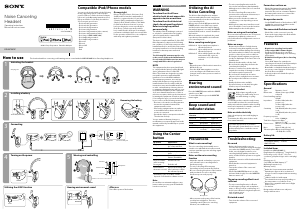




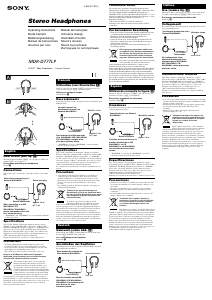
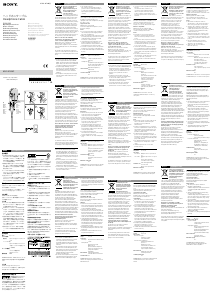
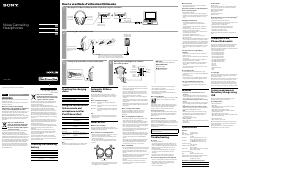
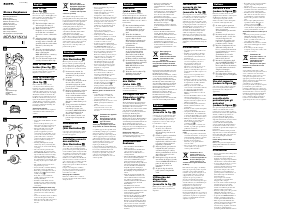
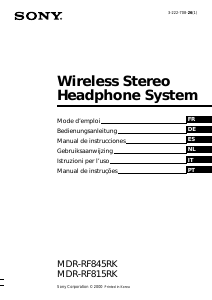
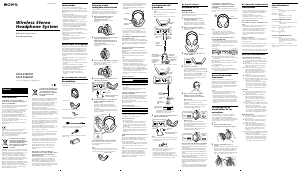
Únase a la conversación sobre este producto
Aquí puedes compartir lo que piensas sobre Sony DR-NC201iP Auriculares. Si tiene alguna pregunta, primero lea atentamente el manual. Puede solicitar un manual utilizando nuestro formulario de contacto.